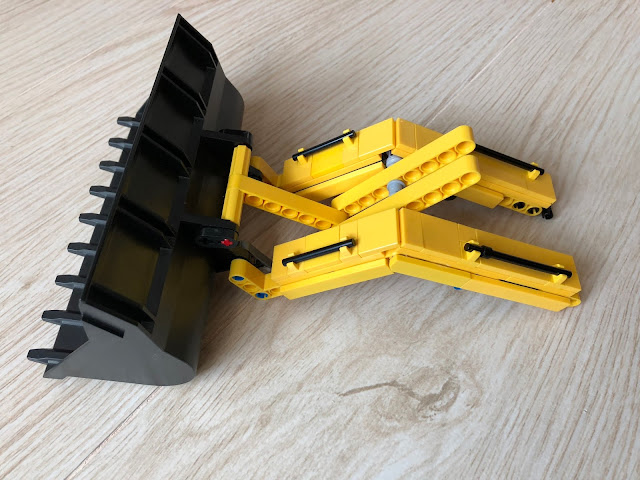http://norman0812.blogspot.com/2018/04/motorized-cat-963d-track-loader.html.
I used two XL-motors for the stick curling and grapple bucket, one M-motor for the turret turning and one RC-motor for the boom. The RC-motor is mainly used for remote control car for its spped, the torque is similar to a XL-motor. So I don't need a complicated gear system to achieve the desired speed.
Complete Machine
This year, I like to build a wheeled excavator in 2-3 months' time. As I had the experience of building the Lego 8043, it should be not very difficult. There are a number of wheeled excavator MOCs in the internet for reference.
Among of them, I feel that the one completed by Pipasseyoyo is the best but only with photos and power-train diagram for reference.
The outlook of my wheeled excavator I intended to build will use CAT 314F as reference, as I have two boxes of technic parts, I will build it gradually at the same time to order the suitable parts or colour.
Undercarriage
Similar to any wheeled models, the wheeled excavator is comprising of steering and driving axles. The steering is controlled by a servo-motor, the driving axle is a differential design and driving by a L-motor. As the two wheels are travelling at different speed, the differential would make the travel smoothier. After completing the undercarriage, the next steep is to consider on how to put the IR receivers and battery box.
Oridinary wheeled models required only two motors, for steering and travel. Wheeled excavator required four motors for steering, travel, front blade and rear outriggers, and two IR receivers. With 4 motors requiring higher motor power, a large battery box is needed to extend the battery changing interval.
The battery box and IR receivers are nicely placed between the front and rear wheels.
Front blade & Rear Outriggers
After a week of trial and error, I finally finished the building of the front blade and rear outriggers. Wheeled excavator only have 4 wheels on ground and is unstable during digging. The front blade is not only to push dirt but also act as stablizer during digging. Similarly, the rear outriggers needed to be lowered when digging at rear end.
After completing the front balde and rear outriggers, it is time to conisder on how to connect them with motors. The space between rear wheels can only install two motors, finally I find some space between the batttery box and receivers for the third motos. By using gears and connecting rods, it is not very difficult to connect the front blade and rear outriggers with motors. The next step is to connect them with power and receivers for testing.
After a week of testing and adjusting the gears, connecting cables, etc. The undercarriage can be tested for running. Two IR controllers are used, the left one for front blade and rear outriggers, and the right one for travel and steering.
Upper Structure
After a few weeks of trying, dimantling and installating, the upper structure is finally completed.
The original Lego 8043 is using a M-motor for he raise and lowering of he boom. As it is very heavy, it resulted to break he gears. Some improvement [rpjects is to use XL-motor instead. The Lego M-motor is turing faster than the XL-motor, eventhough XL-motor solved the power issue, it is still slow and required complicated gear system to increase the speed.
For the controllers and battery box, after considering I don't have enough space for the battery box and two IR receivers, I opted for an integrated battery/control box for 4 channels. AS the battery capacity is only half of those standard battery box, in addition to the XL and RC motors, it will not last for long and require constant re-charging.
Boom, Stick & Grapple Bucket
As the body is comparatively complicated and required to order more parts, I decided to finish the boom, stick and bucket first. After taking reference of the Lego 8043, I made the boom and stick much more stronger as I am using RC and XL-motor with higher power. The grapple bucket was purchased some time ago and it is handy to use in the project.
Slip Ring
After completing the body, I planned to add a few lighting kits on the machine. As the integrated power/control box don't have an extra power outlet and the body don't have enough space for a largers battery box, I need to get the power from the undercarriage. If I used an ordinary connecting cable, it will be strangled after a few dozen turns.
As I had experience of modifying an excavator using slip ring to provide power to the track motors without any disruption to the turning, I will use the same for his project.
I first cut a 25cm connecting cable into half, put the slip ring in the middle, check the power connection before soldering and closing them with heat shrik tubing. As the inner diameter of the turret turning table is 22mm and the outer diamater of the slip ring is the same, no modification is required.
After almost 3 months, the wheeled excavator is already complted, eventhough there are a few small adjustments is needed.




















































